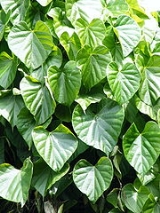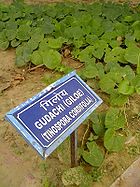
Tinospora cordifolia
Encyclopedia
Tinospora cordifolia, which is known by the common name Guduchi, is an herbaceous
vine
of the family Menispermaceae
indigenous to the tropical areas of India
, Myanmar
and Sri Lanka
.
The plant is a glabrous climbing shrub found throughout India, typically growing in deciduous and dry forests. The leaves are heart shaped. The succulent bark is creamy white to grey in color, with deep clefts spotted with lenticel
s. It puts out long, slender aerial root
s, often growing on mango
or neem
trees. Flowers are yellow, growing in lax racemes from nodes on old wood. Fruits are drupe
s, turning red when ripe.
ic constituents are diterpene compounds, polyphenols, and polysaccharides, including arabinogalactan
polysaccharide (TSP).
 A standardized extract from Tinospora known as Tinofend was clinically researched to eliminate the symptoms of hay fever significantly, compared to placebo.
A standardized extract from Tinospora known as Tinofend was clinically researched to eliminate the symptoms of hay fever significantly, compared to placebo.
Tinospora cordifolia and similar species like Tinospora crispa and Tinospora rumphii Boerl are used in Ayurvedic and Jamu
herbal medicine as a hepatoprotectant, protecting the liver
from damage that may occur following exposure to toxins, as well as in Thailand, Philippines. Recent research has demonstrated that a combination of T. cordifolia extract and turmeric
extract is effective in preventing the hepatotoxicity which is otherwise produced as a side effect of conventional pharmaceutical treatments for tuberculosis
using drugs such as isoniazid
and rifampicin
.
According to the 1918 United States Dispensatory, the plant has a long history of use in India as a medicine and in the preparation of a starch known as Giloe-ka-sat or as Palo.
it is known as Amrutha balli.
In Sri Lanka it is known as Rasakinda.
Herbaceous
A herbaceous plant is a plant that has leaves and stems that die down at the end of the growing season to the soil level. They have no persistent woody stem above ground...
vine
Vine
A vine in the narrowest sense is the grapevine , but more generally it can refer to any plant with a growth habit of trailing or scandent, that is to say climbing, stems or runners...
of the family Menispermaceae
Menispermaceae
Menispermaceae, the botanical name for a family of flowering plants, has been universally recognized by taxonomists. Tubocurare, a neuromuscular blocker and active ingredient in curare, is derived from plants of this family....
indigenous to the tropical areas of India
India
India , officially the Republic of India , is a country in South Asia. It is the seventh-largest country by geographical area, the second-most populous country with over 1.2 billion people, and the most populous democracy in the world...
, Myanmar
Myanmar
Burma , officially the Republic of the Union of Myanmar , is a country in Southeast Asia. Burma is bordered by China on the northeast, Laos on the east, Thailand on the southeast, Bangladesh on the west, India on the northwest, the Bay of Bengal to the southwest, and the Andaman Sea on the south....
and Sri Lanka
Sri Lanka
Sri Lanka, officially the Democratic Socialist Republic of Sri Lanka is a country off the southern coast of the Indian subcontinent. Known until 1972 as Ceylon , Sri Lanka is an island surrounded by the Indian Ocean, the Gulf of Mannar and the Palk Strait, and lies in the vicinity of India and the...
.
The plant is a glabrous climbing shrub found throughout India, typically growing in deciduous and dry forests. The leaves are heart shaped. The succulent bark is creamy white to grey in color, with deep clefts spotted with lenticel
Lenticel
A lenticel is an airy aggregation of cells within the structural surfaces of the stems, roots, and other parts of vascular plants. It functions as a pore, providing a medium for the direct exchange of gasses between the internal tissues and atmosphere, thereby bypassing the periderm, which would...
s. It puts out long, slender aerial root
Aerial root
Aerial roots are roots above the ground. They are almost always adventitious. They are found in diverse plant species, including epiphytes such as orchids, tropical coastal swamp trees such as mangroves, the resourceful banyan trees, the warm-temperate rainforest rātā and pōhutukawa Aerial roots...
s, often growing on mango
Mango
The mango is a fleshy stone fruit belonging to the genus Mangifera, consisting of numerous tropical fruiting trees in the flowering plant family Anacardiaceae. The mango is native to India from where it spread all over the world. It is also the most cultivated fruit of the tropical world. While...
or neem
Neem
Azadirachta indica is a tree in the mahogany family Meliaceae. It is one of two species in the genus Azadirachta, and is native to India growing in tropical and semi-tropical regions. Its fruits and seeds are the source of neem oil...
trees. Flowers are yellow, growing in lax racemes from nodes on old wood. Fruits are drupe
Drupe
In botany, a drupe is a fruit in which an outer fleshy part surrounds a shell of hardened endocarp with a seed inside. These fruits develop from a single carpel, and mostly from flowers with superior ovaries...
s, turning red when ripe.
Constituents
The active adaptogenAdaptogen
An adaptogen is a herbal product claimed to increase resistance to stress, trauma, anxiety and fatigue. The term is used mainly by herbalists who also refer to adaptogens as rejuvenating herbs, qi tonics, rasayanas, or restoratives...
ic constituents are diterpene compounds, polyphenols, and polysaccharides, including arabinogalactan
Arabinogalactan
Arabinogalactan is a biopolymer consisting of arabinose and galactose monosaccharides. Two classes of arabinogalactans are found in nature: plant arabinogalactan and microbial arabinogalactan. In plants, it is a major constituent of many gums, including gum arabic, gum gutti and so on...
polysaccharide (TSP).
In herbal medicine

Tinospora cordifolia and similar species like Tinospora crispa and Tinospora rumphii Boerl are used in Ayurvedic and Jamu
Jamu
Jamu is traditional medicine in Indonesia. It is predominantly herbal medicine made from natural materials, such as parts of plants such as roots, leaves and bark, and fruit...
herbal medicine as a hepatoprotectant, protecting the liver
Liver
The liver is a vital organ present in vertebrates and some other animals. It has a wide range of functions, including detoxification, protein synthesis, and production of biochemicals necessary for digestion...
from damage that may occur following exposure to toxins, as well as in Thailand, Philippines. Recent research has demonstrated that a combination of T. cordifolia extract and turmeric
Turmeric
Turmeric is a rhizomatous herbaceous perennial plant of the ginger family, Zingiberaceae. It is native to tropical South Asia and needs temperatures between 20 °C and 30 °C and a considerable amount of annual rainfall to thrive...
extract is effective in preventing the hepatotoxicity which is otherwise produced as a side effect of conventional pharmaceutical treatments for tuberculosis
Tuberculosis
Tuberculosis, MTB, or TB is a common, and in many cases lethal, infectious disease caused by various strains of mycobacteria, usually Mycobacterium tuberculosis. Tuberculosis usually attacks the lungs but can also affect other parts of the body...
using drugs such as isoniazid
Isoniazid
Isoniazid , also known as isonicotinylhydrazine , is an organic compound that is the first-line antituberculosis medication in prevention and treatment. It was first discovered in 1912, and later in 1951 it was found to be effective against tuberculosis by inhibiting its mycolic acid...
and rifampicin
Rifampicin
Rifampicin or rifampin is a bactericidal antibiotic drug of the rifamycin group. It is a semisynthetic compound derived from Amycolatopsis rifamycinica ...
.
According to the 1918 United States Dispensatory, the plant has a long history of use in India as a medicine and in the preparation of a starch known as Giloe-ka-sat or as Palo.
Common names
There are many common names for this species in different languages. In KarnatakaKarnataka
Karnataka , the land of the Kannadigas, is a state in South West India. It was created on 1 November 1956, with the passing of the States Reorganisation Act and this day is annually celebrated as Karnataka Rajyotsava...
it is known as Amrutha balli.
In Sri Lanka it is known as Rasakinda.

